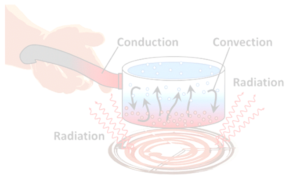Table of Contents
Heat transfer has been defined by thermodynamic systems as the movement of heat across a system’s boundary caused by a temperature difference between the system and its surroundings.
Surprisingly, the temperature difference is said to be a ‘potential’ that causes heat to be transferred from one point to another. Furthermore, heat is also referred to as flux.
Heat could move from one location to another in a variety of ways. Among the various heat transfer modes are:
- Conduction
- Convection
- Radiation
In the meantime, if the two systems have different temperatures, heat will find a way to transfer from the higher to the lower system.

Conduction
Conduction is indeed the process by which heat flows from objects of higher temperature to objects of lower temperature.
A greater kinetic energy area transfers thermal energy to a lesser kinetic energy area. Once high-speed particles collide with slow-moving particles, the slow-moving particles gain kinetic energy. This is really a common type of heat transfer that occurs through physical contact. Conduction could also be referred to as thermal conduction or heat conduction.
The equation that can be used to calculate the rate of conduction is:

Examples:
- Clothing ironing is indeed an example of conduction because heat is transferred from the iron to the clothes.
- Heat transfer occurs from the hands to the ice cube, causing the ice cube to melt when held in the hands.
Convection
The motion of fluid molecules from higher temperature regions to lower temperature regions has been referred to as convection.
The convection equation will be Q = hc ∙ A ∙ (Ts – Tf).
Examples:
- Water boils because molecules that are denser move to the bottom while molecules that are less dense move to the top, resulting in a circular motion of the molecules that heat the water.
- Warm water moves towards the poles as it approaches the equator, while cooler water moves away from the poles as it approaches the equator.
- Blood circulation in warm-blooded animals has been aided by convection, which regulates body temperature.
Radiation
Radiant heat seems to be present in our daily lives in some form or another. Radiant heat is indeed the term used to describe thermal radiations. The emission of electromagnetic waves produces thermal radiation. The energy from the emitting body is carried away by these waves. Radiation is transmitted through a vacuum or a transparent medium, which can be solid or liquid. Thermal radiation has been caused by the random movement of molecules in matter. The emission of electromagnetic radiation is caused by the movement of charged electrons and protons.
The thermocouple is really a device that measures radiation heat transfer. Temperature is measured using a thermocouple. Errors can happen in this device when measuring temperature via radiation heat transfer.
The Stefan-Boltzmann law could be used to calculate thermal radiation:
P = e ∙ σ ∙ A· (Tr – Tc)4
Examples:
- Radiation could be seen in the form of microwave radiation emitted by an oven.
- UV rays emitted by the sun are indeed an example of radiation.
- Radiation could be seen in the release of alpha particles during the decay of Uranium-238 into Thorium-234.
FAQs
How is electromagnetic radiation emitted?
Electromagnetic radiations have been emitted when charged electrons and protons move.
What is meant by heat transfer?
Heat transfer corresponds to any or all of several types of phenomena, referred to as mechanisms, that transport energy and entropy from one location to another. Convection, thermal radiation, and conduction seem to be the common names for the various mechanisms.









